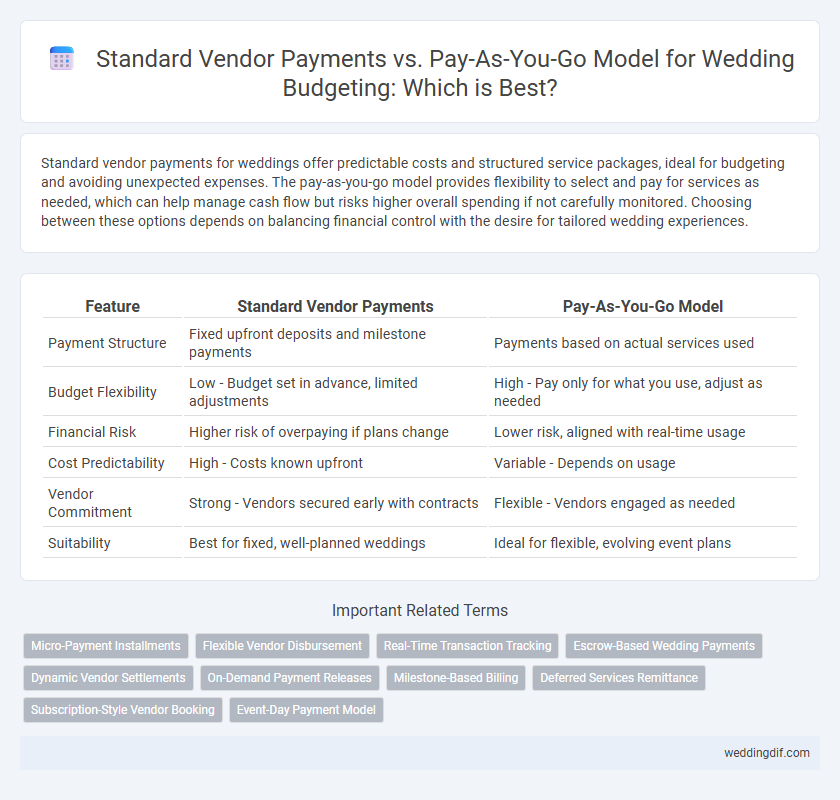Standard vendor payments for weddings offer predictable costs and structured service packages, ideal for budgeting and avoiding unexpected expenses. The pay-as-you-go model provides flexibility to select and pay for services as needed, which can help manage cash flow but risks higher overall spending if not carefully monitored. Choosing between these options depends on balancing financial control with the desire for tailored wedding experiences.
Table of Comparison
| Feature | Standard Vendor Payments | Pay-As-You-Go Model |
|---|---|---|
| Payment Structure | Fixed upfront deposits and milestone payments | Payments based on actual services used |
| Budget Flexibility | Low - Budget set in advance, limited adjustments | High - Pay only for what you use, adjust as needed |
| Financial Risk | Higher risk of overpaying if plans change | Lower risk, aligned with real-time usage |
| Cost Predictability | High - Costs known upfront | Variable - Depends on usage |
| Vendor Commitment | Strong - Vendors secured early with contracts | Flexible - Vendors engaged as needed |
| Suitability | Best for fixed, well-planned weddings | Ideal for flexible, evolving event plans |
Understanding Standard Vendor Payments in Weddings
Standard vendor payments in weddings involve predetermined, fixed costs agreed upon before the event, providing couples with financial predictability and easier budgeting. These payments often cover services like catering, photography, and venue rental, with contracts specifying all deliverables and timelines. Understanding standard vendor payments helps couples avoid unexpected expenses and manage their wedding budget efficiently.
What Is the Pay-As-You-Go Model for Wedding Expenses?
The Pay-As-You-Go model for wedding expenses involves making incremental payments to vendors based on services rendered or milestones achieved, rather than paying a fixed upfront amount. This approach allows couples to better manage cash flow and adjust their budget dynamically as the wedding planning progresses. It contrasts with standard vendor payments, which typically require lump-sum deposits or full payments well before the event date.
Key Differences Between Traditional and Pay-As-You-Go Payments
Standard vendor payments for weddings involve fixed contracts with predetermined fees, ensuring budget certainty but limited flexibility. The pay-as-you-go model allows couples to pay incrementally based on actual services used, promoting cash flow management but potentially leading to unpredictable expenses. Key differences include payment timing, financial commitment, and adaptability to changing plans, impacting overall budget control and vendor relationships.
Pros and Cons of Standard Vendor Payments
Standard vendor payments for weddings offer predictable budgeting by locking in fixed costs, reducing the risk of unexpected expenses and simplifying financial planning. However, this model may lack flexibility, as clients must commit to full payments upfront or by set milestones, potentially limiting adjustments based on changing needs or preferences. Additionally, vendors might charge premium rates for guaranteed bookings, affecting overall budget efficiency.
Advantages and Drawbacks of Pay-As-You-Go Wedding Financing
The pay-as-you-go wedding financing model offers flexibility by allowing couples to manage expenses incrementally, reducing upfront financial burden and minimizing debt accumulation. This approach improves cash flow control but may result in higher overall costs due to potential vendor price changes or missed early payment discounts. Unlike standard vendor payments with fixed contracts, pay-as-you-go requires diligent tracking to avoid budget overruns and ensure all services are secured on time.
Budget Flexibility: Comparing Payment Models
Standard vendor payments typically require fixed deposits and scheduled installments, limiting budget flexibility and increasing financial commitment upfront. The pay-as-you-go model allows couples to manage expenses incrementally, adapting their spending according to real-time needs and unexpected changes. This model often provides greater control over cash flow, reducing the risk of overspending and enhancing overall budget management for weddings.
Cash Flow Management for Each Payment Approach
Standard vendor payments require upfront lump-sum payments, which can strain cash flow but allow for predictable budget planning and fewer surprises. The pay-as-you-go model offers greater flexibility by spreading costs over time, improving short-term cash flow management but potentially leading to higher cumulative expenses due to incremental fees. Effective cash flow management for weddings involves balancing immediate liquidity constraints with long-term financial commitments based on the chosen payment approach.
Vendor Relationships and Contract Considerations
Standard vendor payments establish fixed costs and formal contracts, fostering clear expectations and stronger vendor relationships through guaranteed payments. The pay-as-you-go model offers flexibility but may result in less commitment and potential uncertainty in vendor availability or pricing. Careful contract considerations, including cancellation policies and payment schedules, are essential to maintain trust and minimize financial risks in both budgeting approaches.
Risk Management: Payment Security and Liability
Standard Vendor Payments offer predictable budgeting with fixed costs, reducing the risk of unexpected expenses and ensuring contractual payment security. The Pay-As-You-Go model increases liability exposure due to variable costs and potential payment disputes, requiring vigilant tracking and flexible cash flow management. Effective risk management in wedding budgeting prioritizes secure payment methods and clearly defined vendor agreements to minimize financial uncertainty.
Choosing the Best Payment Model for Your Wedding Budget
Selecting the ideal payment model for your wedding budget depends on vendor reliability, anticipated service needs, and cash flow flexibility. Standard vendor payments often require upfront deposits and fixed fees, providing predictable expenses and securing services well in advance. Pay-as-you-go models offer payment flexibility aligned with actual usage, helping manage cash flow but may risk higher overall costs or availability issues.
Standard Vendor Payments vs Pay-As-You-Go Model for weddings. Infographic

 weddingdif.com
weddingdif.com